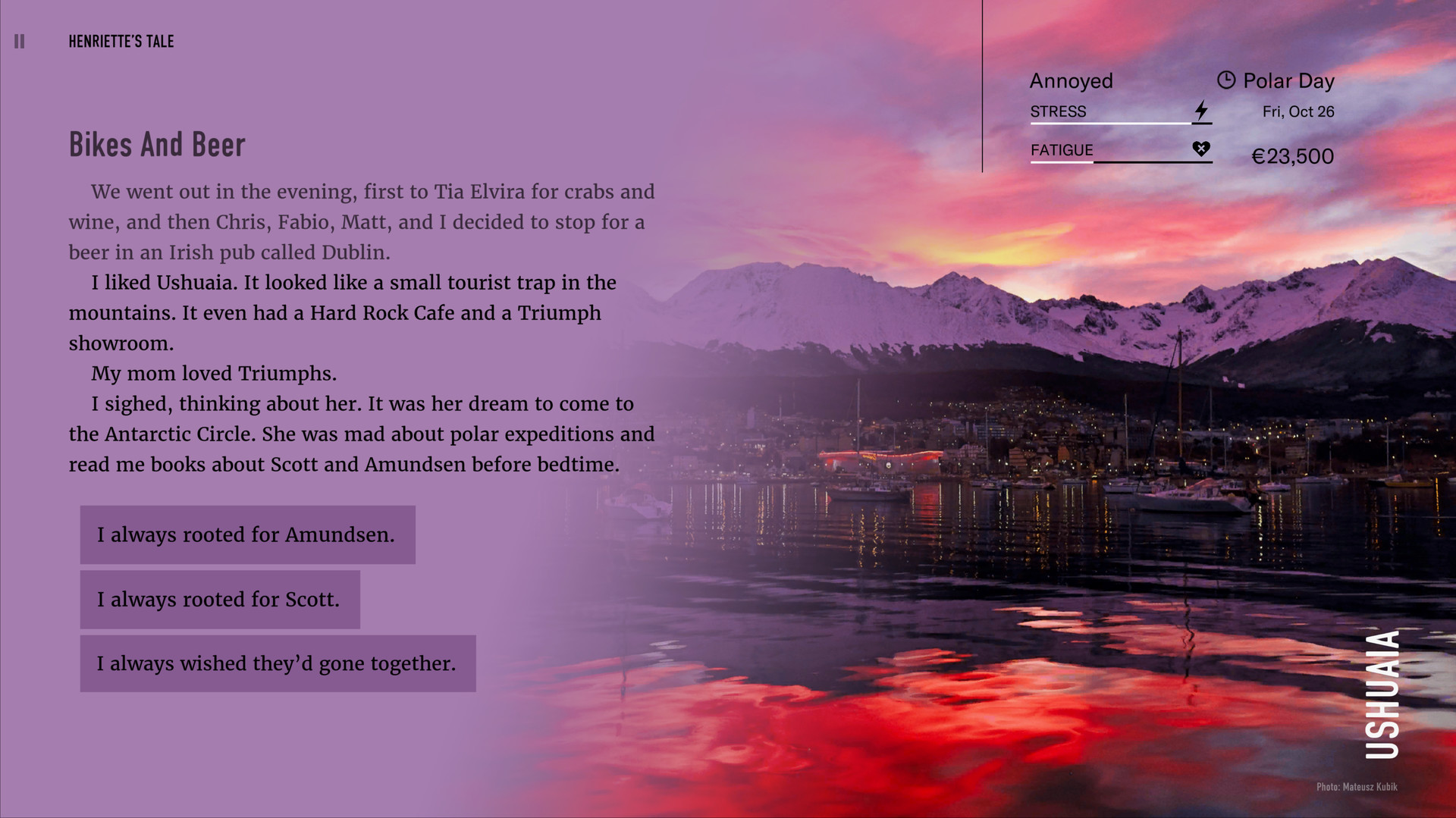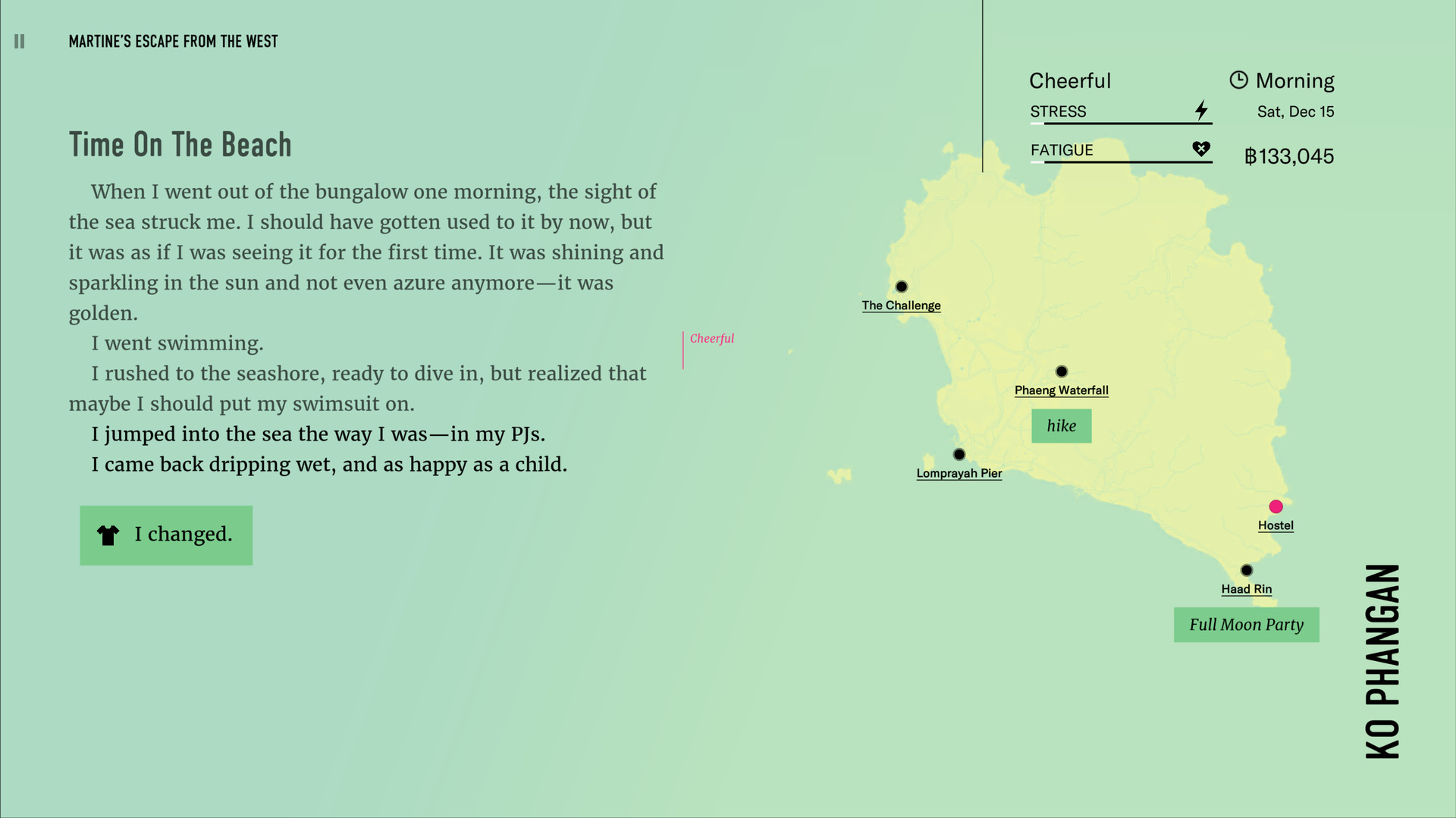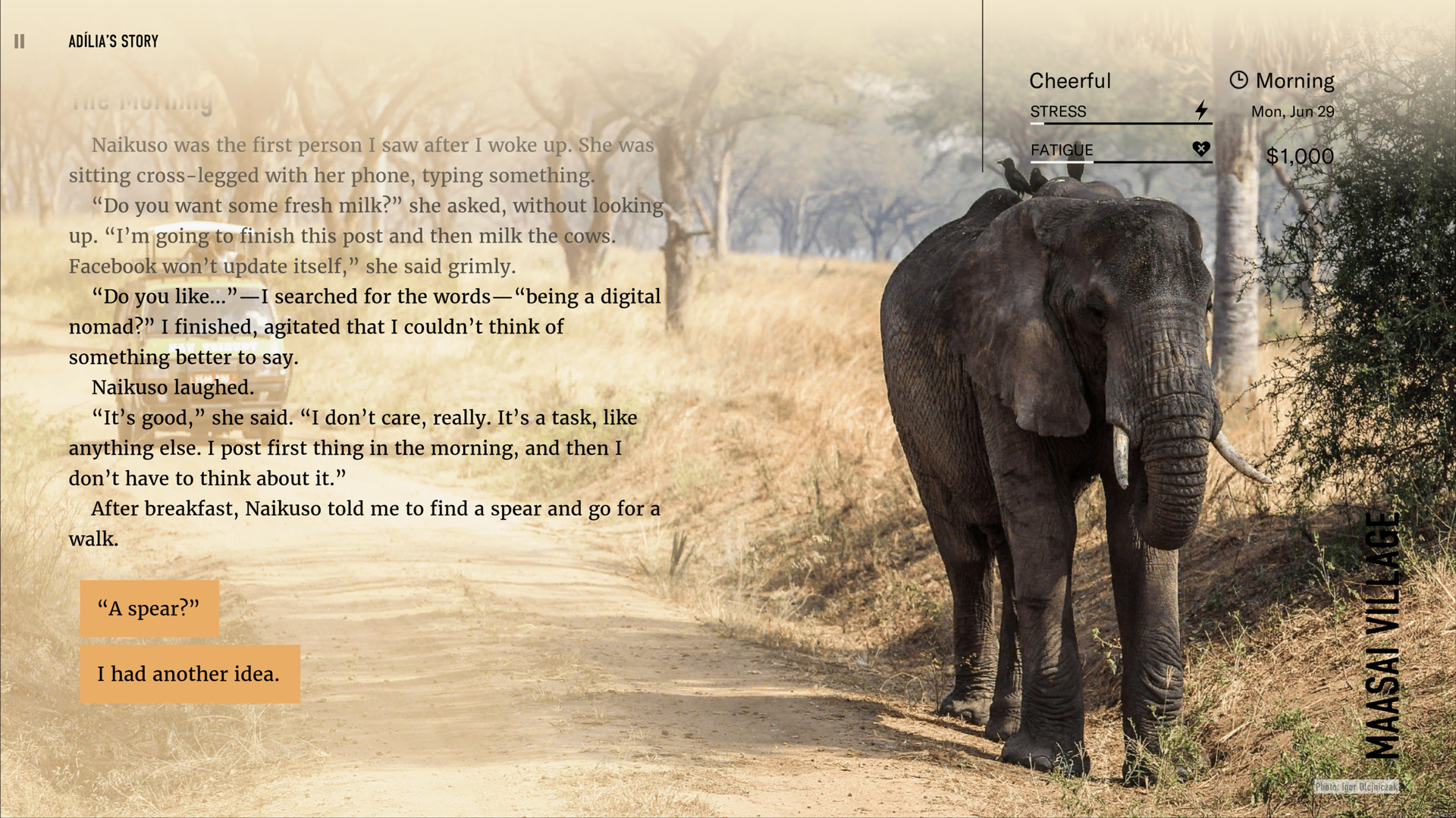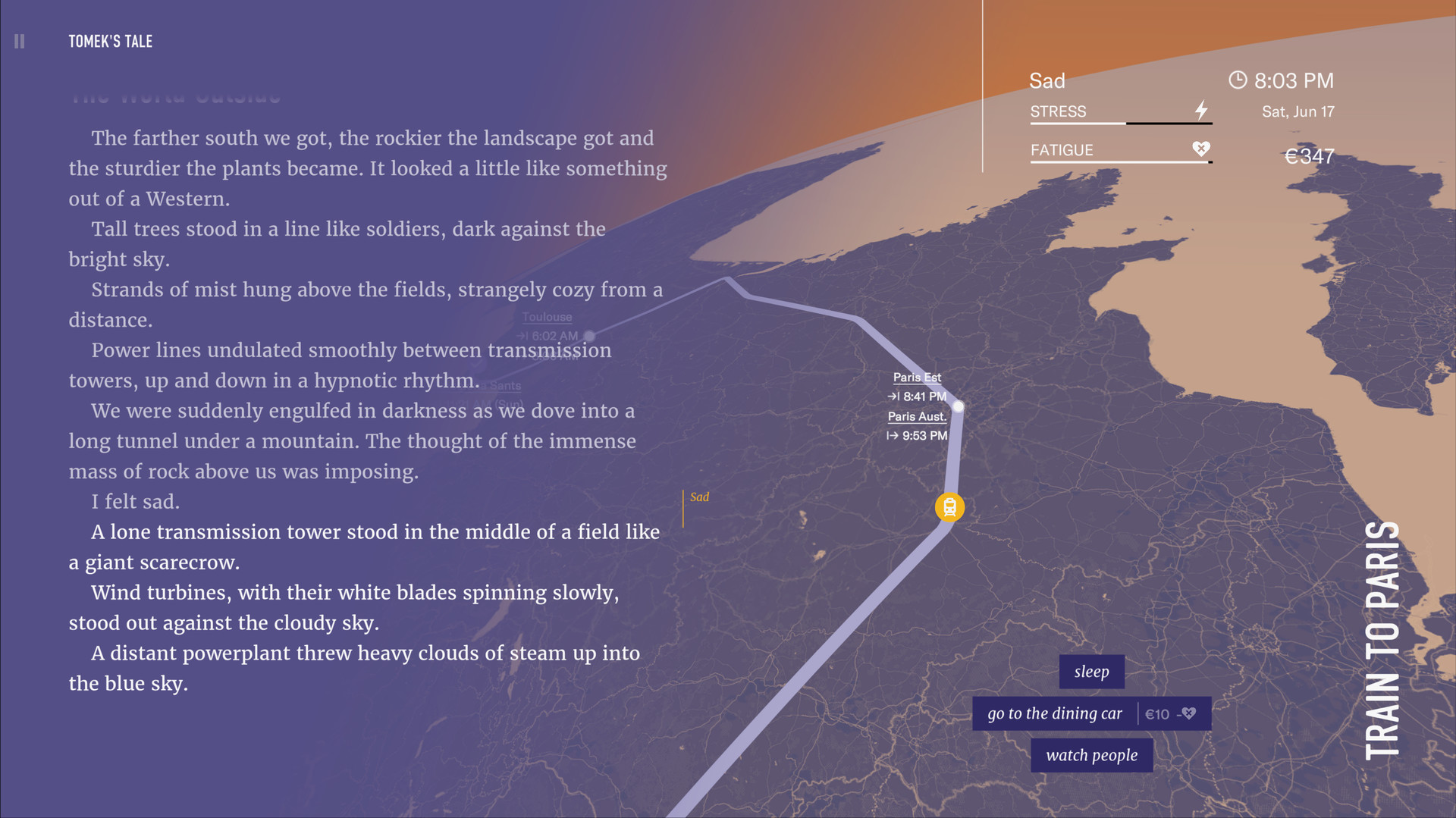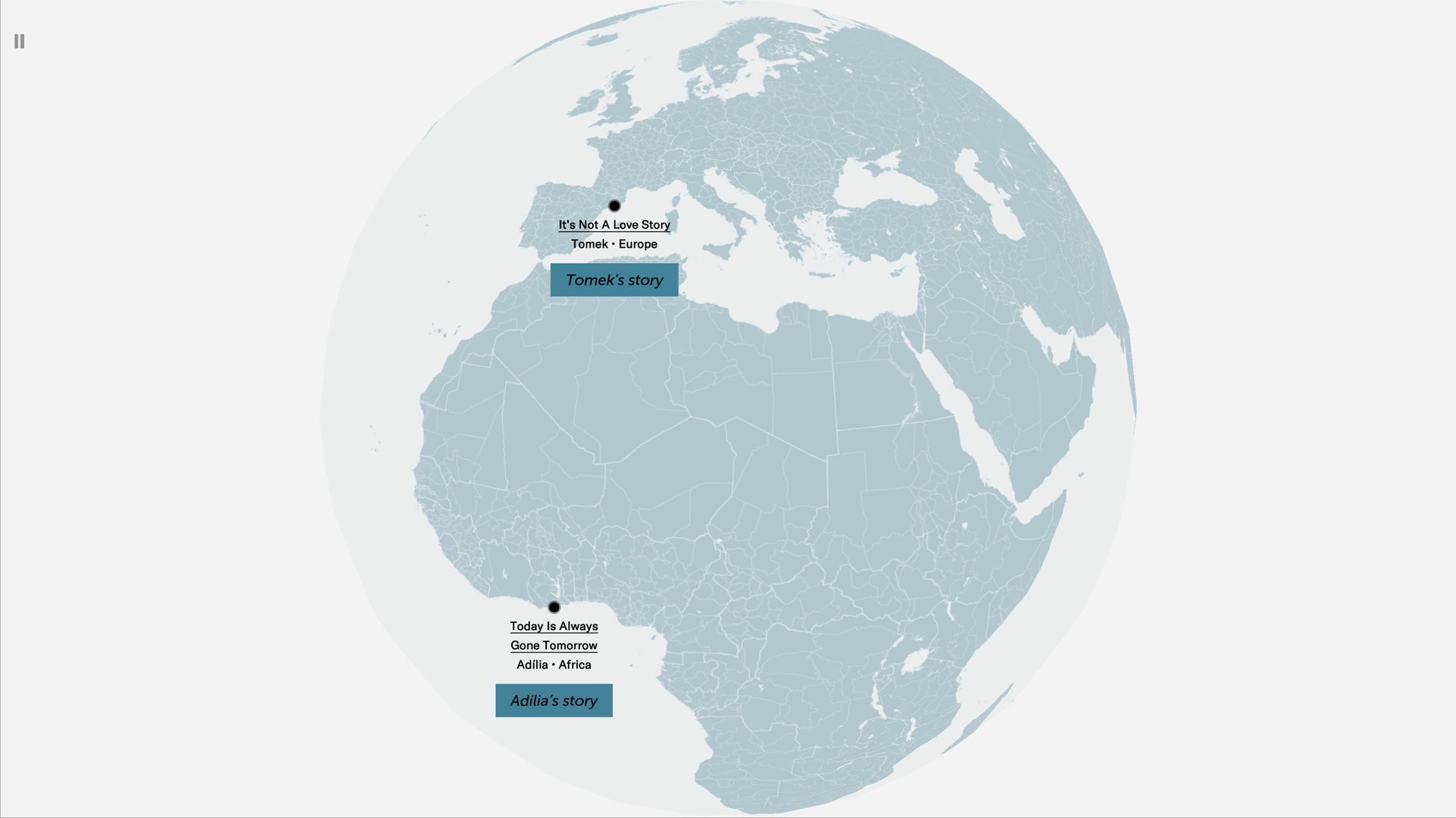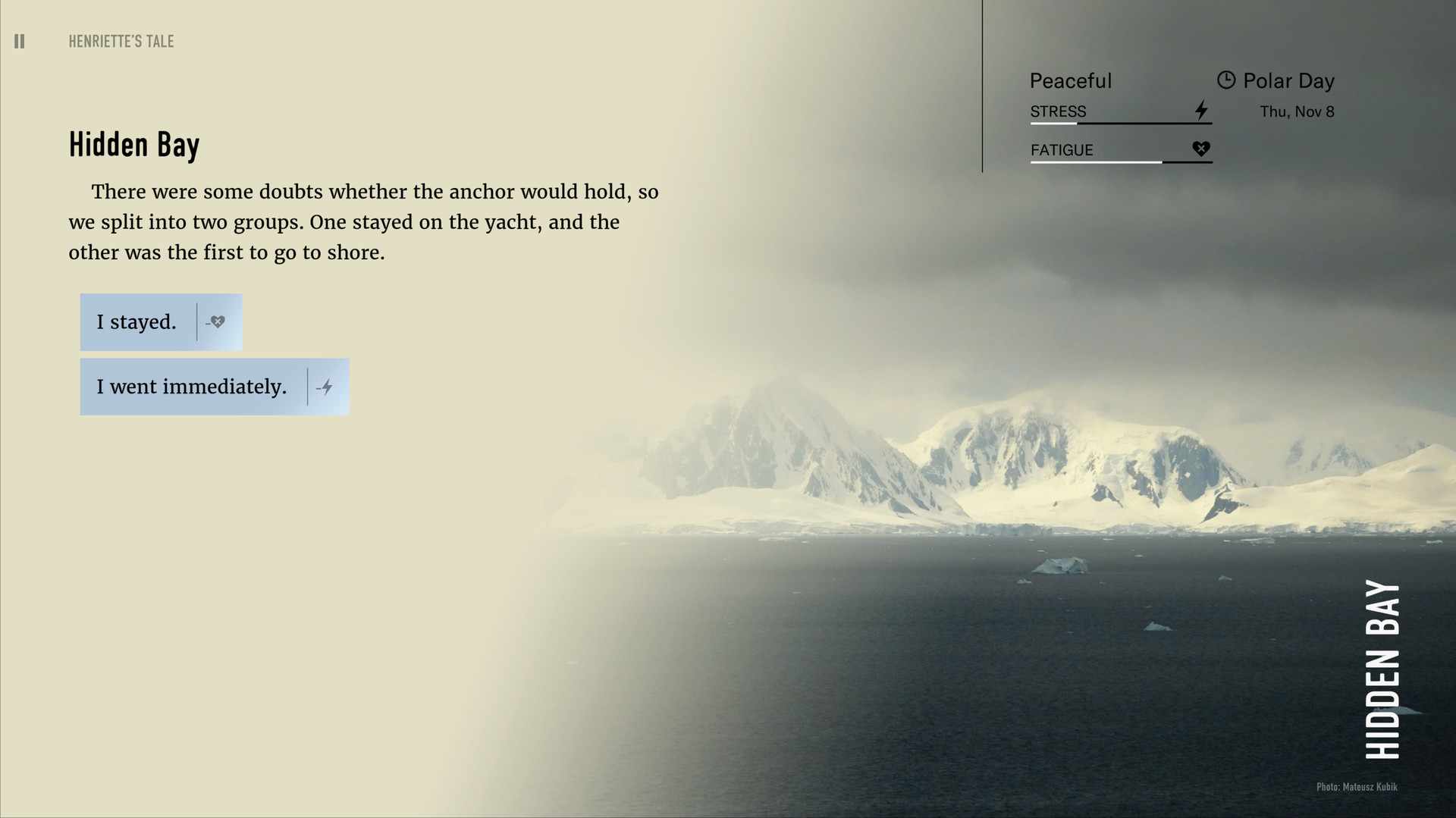
Every journey is about experiences and emotions. With one comes the other. And it all starts with one emotion so intense that you just have to give in to it. Wanderlust.
Wanderlust Travel Stories is a text-based travel game set in the real world.

Emotional Stories. They are driven by hope and curiosity, the search for love, and the need to deal with grief—an idealistic student, a jaded reporter, a man who has never traveled before. Walk with them, shape their paths, and see the world through their eyes.
Immersive Travels. From the mysterious statues of Rapa Nui, through the bustling streets of Bangkok and the vast, pristine expanses of the Antarctic, to the grasslands of the Serengeti, explore places you might never see and examine your feelings toward the places you know.
Personalized Experience. There are many things to consider: what to pack, when to leave, where to stay. Be careful to manage your stress and fatigue, because they change the way you see the world. Create a journey of your own with every choice you make.
Real Stories, Real World. Wanderlust was created by a team of travelers, journalists, artists, and game makers. Inspired by real-life adventures, these stories have been illustrated with bespoke photographs taken especially for the project or selected from private archives.
Playable Documentary. With its unique mix of slice-of-life and journalism, Wanderlust touches subjects from the melting polar caps, to the impact of the tourism industry, to the universal search for the meaning of life. Take a fresh look at your notions about the world.
Slow Gaming. You don’t have to rush. You don’t have to fight. This is your journey and you decide the pace of your adventure. Relax to the calming original soundtrack. Give yourself space to think and feel. Observe how the journey changes you.

Wanderlust Travel Stories is a game and a book. Travel the world in four novels and five short stories spanning a total of over 300,000 words and 12 hours worth of reading.
It’s Not a Love Story. He didn’t plan to be spontaneous, but it happened. Now he has to travel across all of Europe to meet a woman he doesn’t really know. His hopes are high. He might be in love. He’ll probably be late.
The Essential Gap Year. With every new experience, Martine has that nagging feeling that she’s changed. But is that something she needs during her perfect gap year? All she wanted was to go to Asia and find the meaning of life, just like everybody else.
Sea Fever. Antarctica. A luxury cruiser. A yacht. A father. A daughter. Old friends. New enemies. The cold, uncaring sea.
Today Is Always Gone Tomorrow. Adília felt too young for her best friend to die, too young to be fed up with her husband, and definitely too young to become a grandmother. She needed to think, to cross Africa one more time, to spend a moment alone. Six months. Maybe more. Everyone will manage while she’s gone.
Short Stories. An American circus sideshow, a rusting plane in Papua New Guinea, trolls and whales on the Faroe Islands, a sweatshop in Bangladesh—a collection of unexpected snapshots from the protagonists’ lives.
Wanderlust. A chance meeting on the world’s most remote island gets a group of tourists talking about their life journeys, their pasts and futures, their hopes and fears. With every story, passions flare and tempers rise as the travelers re-examine what they brought with them and what they left behind. Faces carved in stone watch them from the darkness.

For more travel stories follow Wanderlust on our social media channels.
(Facebook, Twitter, Instagram)
The article was originally posted on Gamasutra by Artur, our game designer.
We knew from the very beginning that we wanted to have a marine tale in Wanderlust Travel Stories, and we even wrote a draft of a chapter set in the Caribbean. Then, in October 2018, Mateusz Kubik, who was a researcher in our team and a skipper, sailed to the Antarctic on a brave steel ketch named Selma. He came back with a detailed account of his journey and a few memory cards worth of photographs, and we knew that our protagonists were heading towards much colder waters.
Introduction
There are two types of narrative content in Wanderlust Travel Stories: scenes and flow. A scene was your default branching/interactive text you navigated and shaped by making choices. More on how we made the choices personal, see this post.One of the cornerstones of our design was to make you feel like it was your journey, make you the traveler, not just someone who listens to a travelers story. And if there was something that we found in every travel story we heard, it was the meditative moments when you sit and watch the landscape roll outside the window. We decided to recreate those moments in the game, and we called the mechanism the flow.
This post details how we used a very simple procedural generation to narrate our heroine sailing through the icy waters of the Antarctic.
Go With The Flow
To recreate the moments of travel, we used a number of tools. The first was to take a degree of control from the player in the flow, a map is displayed and text appears by itself, as the dot moves along the chosen path. Music and ambient sounds heighten the feeling of movement. Choices appear from time to time, allowing the player to shape their travel and literary experience: enjoy the views, interact with fellow travelers, read, get lost in thoughts or maybe just sleep?When preparing Henriettes flow in the Antarctic story we faced a unique challenge: we wanted to relay a truth about sailing and use Mateuszs input experiences to the fullest while keeping the story tailored by players choices and interesting.
Notes From The Frozen Seas
We started with the map, detailing the boats route and estimated times for every leg of the journey. That was relatively easy to bring into the game, although choosing the right cameras took some time. After some experiments, we decided for one place, where the players decisions could cut two days of travel, but apart from that, we decided for a set speed of the boat.
We start on the Falkland Islands/Islas Malvinas, sail west, then south, and back to Ushuaia.
The life onboard is ruled by the changing of watches, and we got the schedule described firsthand. Mateusz prepared a handy table explaining how watches changed with a crew of eight people, and what each watch was responsible for. We started with that.

Life on a boat: many occasions to get cold, little time for yourself.
Apart from the watches, we wanted to show all aspects of life on a boat: the views by day and by the short polar night, the weather, the time spent below deck, the technicalities of sleep, the food and the chores.
Simulated Boredom
I started with writing a convoluted script in Ink, that was supposed to watch the schedule and switch between the flow depicting the views and the description of watches at the appropriate times. It knew when your next watch was, and whether it was a galley or a navigation watch. It had those neat extra sentences connecting the views and the work into one narrative. Sometimes it was even aware that you needed to eat and added the meal description into the flow. We tested it, and to my dismay, the result was utterly boring.The problem soon became clear: to simulate the schedule we needed a new text every hour, an hour and a half. For a 64-hour-long sailing, it amounted to at least 42 lines on the screen. With a new line appearing every 12 seconds, it amounted to almost nine minutes of staring at the screen and listening to the howling of the wind and the flapping of sails.
Quite accurate if you wanted to show the inevitable, boring side of sailing, but also way too boring for our readers. After some testing, we found an acceptable ratio: 16 lines for 64 hours, one line every 4 hours. With watches lasting three hours, it became clear to us, that simulating the sail watch after watch was not an option.
The whole process would have been easier if I had thought more about our core design principles for the game, instead of just having fun with writing convoluted Ink scripts. From the very beginning, we had this idea, that we wanted to simulate not the boring parts of traveling, but the feelings and emotions of a traveler.
Which, again and again, proved a good idea for the game we were working on.
A Sailors Life
In the end, we made every leg of a journey into a personified journal entry: Henriette talking about her experiences on the watch, of the views she saw, of the life on the boat. As in many other places in Wanderlust Travel Stories, we prepared the structure and let players fill in the details in the way they liked.Let me show you how the flow in Antarctica worked.
And We Sailed
Every leg of a journey started with an intro, sometimes differentiated by the characters mood.
The situation is the same, Henriettes perception differs.
In most of the scenarios Henriette started on the deck of the boat, only deep in the Antarctic she started the journey sitting in the galley. From that moment on, we let the player and the scripts compose most of the narrative.
We usually started with describing the views or scenes from the galley those are described in the next sections. Sooner or later, a watch started.
On My Watch
To ensure a smooth transition, we wrote a number of connecting sentences, accounting for what Henriette was doing at the moment, and for whether it was a navigation, or a galley watch. We used similar sentences to end the watch.
If Henriette is asleep, the watch will be introduced with different phrasing.
We wrote new variants until the repetition was no longer visible to players.
Henriettes impressions were taken from Mateuszs notes, cut into short phrases, and sentences and randomly rebuilt during the game to create a varied array of comments.

A random collection of snippets from a sailors life.

Its hard to convey the isolation you feel at night in the middle of a sea, but we tried.
But the part of the watch most noticeable for the player was the choice about whether to talk to Chris or just focus on sailing. Focusing on the boat made Henriette a better sailor, while conversation made her better with people both paths finding their conclusion in the storys final scenes.
The nature of the conversation changed based on the mood Henriette was in: from complaining about an obnoxious crew member, through discussing the climate crisis, to a collection of dad jokes that I decided not to quote here.

To feed nine people over five weeks of sailing you need a ton of food. Literally.
If you wondered, the meals described in the game, are based on what Mateusz really cooked.
Beautiful Cold Seas
After the watch, the player could decide whether to say on the deck or to sit in the galley. One option more tiring, the other allowing for a moment of rest. One showing the views outside the boat, the other snippets from the crews daily routines. When it was night or Henriette was very tired, sleep also became an available option.Depending on the players choices the game reached different boxes filled with sentences for every occasion and put a narrative together. Here and there we procedurally added comments reflecting Henriettes current mood.
Every leg of a journey had its own views for a day and a night (with the night getting shorter the more south the boat sailed), while the scenes under the deck consisted of micro-stories developing at their own pace.

Chris always reads a book about Antarctica, but the title comments on players previous choices.
Where possible, we tried to comment on the players previous decisions or the characters current mood.
We Anchored
Every flow ended with a sentence introducing the next scene.
Almost every sentence on the screen depends on the players input.
All in all, those mechanisms and choices created a rather smooth narrative about sailing from point A to point B.
The Final Touches
When we put it together we noticed that we still have a number of beautiful pictures unused, so we added an extra choice here and there, that (if chosen) triggered a small scene, breaking the monotony of the flow just like a beautiful view breaks the monotony of a lonely watch.
Choices may vary, depending on the circumstances.

Penguins, watching you watching them.
Summary
As you can see, working on our documentary input material we went from an hour-to-hour simulation to a more journal-like approach. Most of the narrative in the flow parts of the story is procedurally generated, paragraphs constructed from smaller parts or randomly chosen from different bags. The system decides which bag to choose, based on the players input both explicit (choices) and indirect (Hentriettes mood), the watches schedule, time of day, and location. Sometimes we used connecting sentences, ex. I was woken with a shake. It was time to start my watch. to keep the narrative flowing.The main choices in the flow, from the story perspective, are about what is more important for Henriette: sailing and the views, or relations and her crew-mates.
The texts are composed of actual notes from sailing through the Antarctic, and we hope the overall narrative is credible enough to show you a truth about sailing and personal enough to keep it interesting.
As my mother said, reading through Henriettes story: I would never go there, its way too cold and yet, people do.
Minimum Setup
- Processor: Dual core or betterMemory: 4 GB RAM
- Memory: 4 GB RAM
- Graphics: Intel HD 4400 or better
- Storage: 2 GB available space
[ 6437 ]
[ 7253 ]
[ 3708 ]
[ 5362 ]

